Science & Environment
- Thread starter socratus
- Start date
You are using an out of date browser. It may not display this or other websites correctly.
You should upgrade or use an alternative browser.
You should upgrade or use an alternative browser.
Ancient DNA from Russian caves gives rare snapshot of Neanderthal family ties
Men stayed near home, while women migrated to mate, evidence suggests
Author of the article:Associated Press
Associated Press
Maddie Burakoff
Publishing date:Oct 20, 2022 • 22 hours ago • 3 minute read • Join the conversation
A reconstruction of a Neanderthal father and his daughter is seen in this undated handout photo provided by the Max Planck Institute for Evolutionary Anthropology in Leipzig, Germany.
A reconstruction of a Neanderthal father and his daughter is seen in this undated handout photo provided by the Max Planck Institute for Evolutionary Anthropology in Leipzig, Germany. PHOTO BY TOM BJORKLUND /Max Planck Institute for Evolutionary Anthropology/via REUTERS
A new study suggests Neanderthals formed small, tightknit communities where females may have travelled to move in with their mates.
The research used genetic sleuthing to offer a rare snapshot of Neanderthal family dynamics — including a father and his teenage daughter who lived together in Siberia more than 50,000 years ago.
Researchers were able to pull DNA out of tiny bone fragments found in two Russian caves. In their study, published Wednesday in the journal Nature, they used the genetic data to map out relationships between 13 different Neanderthals and get clues to how they lived.
“When I work on a bone or two, it’s very easy to forget that these are actually people with their own lives and stories,” said study author Bence Viola, an anthropologist at the University of Toronto. “Figuring out how they’re related to each other really makes them much more human.”
Our ancient cousins, the Neanderthals, lived across Europe and Asia for hundreds of thousands of years. They died out around 40,000 years ago, shortly after our species, the Homo sapiens, arrived in Europe from Africa.
Scientists have only recently been able to dig around in these early humans’ DNA. New Nobel laureate Svante Paabo — who is an author on this latest study — published the first draft of a Neanderthal genome a little over a decade ago.
Since then, scientists have sequenced 18 Neanderthal genomes, said lead author Laurits Skov, a geneticist at the Max Planck Institute for Evolutionary Anthropology. But it’s rare to find bones from multiple Neanderthals from the same time and place, he said — which is why these cave discoveries were so special.
“If there was ever a chance to find a Neanderthal community, this would be it,” Skov said.
The caves, located in remote foothills above a river valley, have been a rich source of materials from stone tools to fossil fragments, Viola said. With their prime view of migrating herds in the valley below, researchers think the caves might have served as a short-term hunting stop for Neanderthals.
Chagyrskaya Cave, located in the Altai Mountains of southern Siberia in Russia, is seen in this undated handout photo provided by the Max Planck Institute for Evolutionary Anthropology in Leipzig, Germany.
Chagyrskaya Cave, located in the Altai Mountains of southern Siberia in Russia, is seen in this undated handout photo provided by the Max Planck Institute for Evolutionary Anthropology in Leipzig, Germany.
Archaeologists excavating the caves have found remains from at least a dozen different Neanderthals, Viola said. These remains usually come in small bits and pieces — “a finger bone here, a tooth there” — but they’re enough for scientists to extract valuable DNA details.
The researchers were able to identify a couple of relatives among the group. Along with the father and daughter, there was a pair of other relatives — maybe a boy and his aunt, or a couple of cousins.
Overall, the analysis found that everyone in the group had a lot of DNA in common. That suggests that at least in this area, Neanderthals lived in very small communities of 10 to 20 individuals, the authors concluded.
But not everyone in these groups stayed put, according to the study.
Researchers looked at other genetic clues from mitochondrial DNA, which is passed down on the mother’s side, and the Y chromosome, which is passed down on the father’s side.
The female side showed more genetic differences than the male side — which means females may have moved around more, Skov said. It’s possible that when a female Neanderthal found a mate, she would leave home to live with his family.
University of Wisconsin anthropologist John Hawks, who was not involved in the study, said the research was an exciting application of ancient DNA evidence, even as many questions remain about Neanderthal social structures and lifestyles.
Figuring out how early humans lived is like “putting together a puzzle where we have many, many missing pieces,” Hawks said. But this study means “somebody’s dumped a bunch more pieces on the table.”
![SCIENCE-NEANDERTHALS_-scaled[1].jpg SCIENCE-NEANDERTHALS_-scaled[1].jpg](https://forums.canadiancontent.net/data/attachments/14/14396-9f43289aadc5c0ef9328f2a75eea8862.jpg)

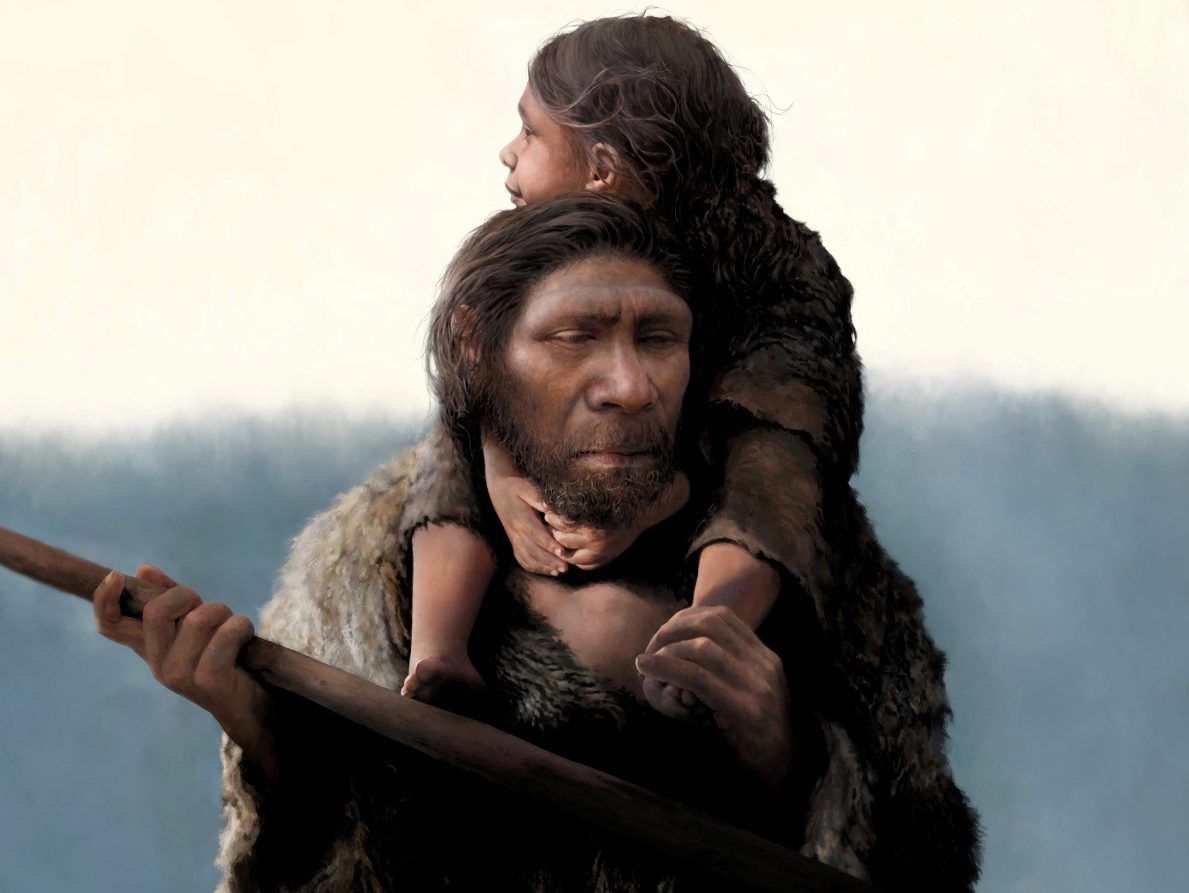
 torontosun.com
torontosun.com
Men stayed near home, while women migrated to mate, evidence suggests
Author of the article:Associated Press
Associated Press
Maddie Burakoff
Publishing date:Oct 20, 2022 • 22 hours ago • 3 minute read • Join the conversation
A reconstruction of a Neanderthal father and his daughter is seen in this undated handout photo provided by the Max Planck Institute for Evolutionary Anthropology in Leipzig, Germany.
A reconstruction of a Neanderthal father and his daughter is seen in this undated handout photo provided by the Max Planck Institute for Evolutionary Anthropology in Leipzig, Germany. PHOTO BY TOM BJORKLUND /Max Planck Institute for Evolutionary Anthropology/via REUTERS
A new study suggests Neanderthals formed small, tightknit communities where females may have travelled to move in with their mates.
The research used genetic sleuthing to offer a rare snapshot of Neanderthal family dynamics — including a father and his teenage daughter who lived together in Siberia more than 50,000 years ago.
Researchers were able to pull DNA out of tiny bone fragments found in two Russian caves. In their study, published Wednesday in the journal Nature, they used the genetic data to map out relationships between 13 different Neanderthals and get clues to how they lived.
“When I work on a bone or two, it’s very easy to forget that these are actually people with their own lives and stories,” said study author Bence Viola, an anthropologist at the University of Toronto. “Figuring out how they’re related to each other really makes them much more human.”
Our ancient cousins, the Neanderthals, lived across Europe and Asia for hundreds of thousands of years. They died out around 40,000 years ago, shortly after our species, the Homo sapiens, arrived in Europe from Africa.
Scientists have only recently been able to dig around in these early humans’ DNA. New Nobel laureate Svante Paabo — who is an author on this latest study — published the first draft of a Neanderthal genome a little over a decade ago.
Since then, scientists have sequenced 18 Neanderthal genomes, said lead author Laurits Skov, a geneticist at the Max Planck Institute for Evolutionary Anthropology. But it’s rare to find bones from multiple Neanderthals from the same time and place, he said — which is why these cave discoveries were so special.
“If there was ever a chance to find a Neanderthal community, this would be it,” Skov said.
The caves, located in remote foothills above a river valley, have been a rich source of materials from stone tools to fossil fragments, Viola said. With their prime view of migrating herds in the valley below, researchers think the caves might have served as a short-term hunting stop for Neanderthals.
Chagyrskaya Cave, located in the Altai Mountains of southern Siberia in Russia, is seen in this undated handout photo provided by the Max Planck Institute for Evolutionary Anthropology in Leipzig, Germany.
Chagyrskaya Cave, located in the Altai Mountains of southern Siberia in Russia, is seen in this undated handout photo provided by the Max Planck Institute for Evolutionary Anthropology in Leipzig, Germany.
Archaeologists excavating the caves have found remains from at least a dozen different Neanderthals, Viola said. These remains usually come in small bits and pieces — “a finger bone here, a tooth there” — but they’re enough for scientists to extract valuable DNA details.
The researchers were able to identify a couple of relatives among the group. Along with the father and daughter, there was a pair of other relatives — maybe a boy and his aunt, or a couple of cousins.
Overall, the analysis found that everyone in the group had a lot of DNA in common. That suggests that at least in this area, Neanderthals lived in very small communities of 10 to 20 individuals, the authors concluded.
But not everyone in these groups stayed put, according to the study.
Researchers looked at other genetic clues from mitochondrial DNA, which is passed down on the mother’s side, and the Y chromosome, which is passed down on the father’s side.
The female side showed more genetic differences than the male side — which means females may have moved around more, Skov said. It’s possible that when a female Neanderthal found a mate, she would leave home to live with his family.
University of Wisconsin anthropologist John Hawks, who was not involved in the study, said the research was an exciting application of ancient DNA evidence, even as many questions remain about Neanderthal social structures and lifestyles.
Figuring out how early humans lived is like “putting together a puzzle where we have many, many missing pieces,” Hawks said. But this study means “somebody’s dumped a bunch more pieces on the table.”
![SCIENCE-NEANDERTHALS_-scaled[1].jpg SCIENCE-NEANDERTHALS_-scaled[1].jpg](https://forums.canadiancontent.net/data/attachments/14/14396-9f43289aadc5c0ef9328f2a75eea8862.jpg)


Ancient DNA from Russian caves gives rare snapshot of Neanderthal family ties
A new study suggests Neanderthals formed small, tightknit communities where females may have travelled to move in with their mates.
wonder if some of the bigfoot sightings could be neanderthals?Ancient DNA from Russian caves gives rare snapshot of Neanderthal family ties
Men stayed near home, while women migrated to mate, evidence suggests
Author of the article:Associated Press
Associated Press
Maddie Burakoff
Publishing date:Oct 20, 2022 • 22 hours ago • 3 minute read • Join the conversation
A reconstruction of a Neanderthal father and his daughter is seen in this undated handout photo provided by the Max Planck Institute for Evolutionary Anthropology in Leipzig, Germany.
A reconstruction of a Neanderthal father and his daughter is seen in this undated handout photo provided by the Max Planck Institute for Evolutionary Anthropology in Leipzig, Germany. PHOTO BY TOM BJORKLUND /Max Planck Institute for Evolutionary Anthropology/via REUTERS
A new study suggests Neanderthals formed small, tightknit communities where females may have travelled to move in with their mates.
The research used genetic sleuthing to offer a rare snapshot of Neanderthal family dynamics — including a father and his teenage daughter who lived together in Siberia more than 50,000 years ago.
Researchers were able to pull DNA out of tiny bone fragments found in two Russian caves. In their study, published Wednesday in the journal Nature, they used the genetic data to map out relationships between 13 different Neanderthals and get clues to how they lived.
“When I work on a bone or two, it’s very easy to forget that these are actually people with their own lives and stories,” said study author Bence Viola, an anthropologist at the University of Toronto. “Figuring out how they’re related to each other really makes them much more human.”
Our ancient cousins, the Neanderthals, lived across Europe and Asia for hundreds of thousands of years. They died out around 40,000 years ago, shortly after our species, the Homo sapiens, arrived in Europe from Africa.
Scientists have only recently been able to dig around in these early humans’ DNA. New Nobel laureate Svante Paabo — who is an author on this latest study — published the first draft of a Neanderthal genome a little over a decade ago.
Since then, scientists have sequenced 18 Neanderthal genomes, said lead author Laurits Skov, a geneticist at the Max Planck Institute for Evolutionary Anthropology. But it’s rare to find bones from multiple Neanderthals from the same time and place, he said — which is why these cave discoveries were so special.
“If there was ever a chance to find a Neanderthal community, this would be it,” Skov said.
The caves, located in remote foothills above a river valley, have been a rich source of materials from stone tools to fossil fragments, Viola said. With their prime view of migrating herds in the valley below, researchers think the caves might have served as a short-term hunting stop for Neanderthals.
Chagyrskaya Cave, located in the Altai Mountains of southern Siberia in Russia, is seen in this undated handout photo provided by the Max Planck Institute for Evolutionary Anthropology in Leipzig, Germany.
Chagyrskaya Cave, located in the Altai Mountains of southern Siberia in Russia, is seen in this undated handout photo provided by the Max Planck Institute for Evolutionary Anthropology in Leipzig, Germany.
Archaeologists excavating the caves have found remains from at least a dozen different Neanderthals, Viola said. These remains usually come in small bits and pieces — “a finger bone here, a tooth there” — but they’re enough for scientists to extract valuable DNA details.
The researchers were able to identify a couple of relatives among the group. Along with the father and daughter, there was a pair of other relatives — maybe a boy and his aunt, or a couple of cousins.
Overall, the analysis found that everyone in the group had a lot of DNA in common. That suggests that at least in this area, Neanderthals lived in very small communities of 10 to 20 individuals, the authors concluded.
But not everyone in these groups stayed put, according to the study.
Researchers looked at other genetic clues from mitochondrial DNA, which is passed down on the mother’s side, and the Y chromosome, which is passed down on the father’s side.
The female side showed more genetic differences than the male side — which means females may have moved around more, Skov said. It’s possible that when a female Neanderthal found a mate, she would leave home to live with his family.
University of Wisconsin anthropologist John Hawks, who was not involved in the study, said the research was an exciting application of ancient DNA evidence, even as many questions remain about Neanderthal social structures and lifestyles.
Figuring out how early humans lived is like “putting together a puzzle where we have many, many missing pieces,” Hawks said. But this study means “somebody’s dumped a bunch more pieces on the table.”
View attachment 16134View attachment 16135

Ancient DNA from Russian caves gives rare snapshot of Neanderthal family ties
A new study suggests Neanderthals formed small, tightknit communities where females may have travelled to move in with their mates.torontosun.com
apparently you have never been to mississauga and brampton.There is somewhere worse than Vancouver?
Lake Mead brain-eating amoeba death still 'very rare,' experts say
Author of the article:Associated Press
Associated Press
Ken Ritter
Publishing date:Oct 21, 2022 • 11 hours ago • 3 minute read • Join the conversation
LAS VEGAS — The death of a Las Vegas-area teenager from a rare brain-eating amoeba that investigators think he was exposed to in warm waters at Lake Mead should prompt caution, not panic, among people at freshwater lakes, rivers and springs, experts said Friday.
“It gets people’s attention because of the name,” former public health epidemiologist Brian Labus said of the naturally occurring organism officially called Naegleria fowleri but almost always dubbed the brain-eating amoeba. “But it is a very, very rare disease.”
The federal Centers for Disease Control and Prevention has tallied just 154 cases of infection and death from the amoeba in the U.S. since 1962, said Labus, who teaches at the School of Public Health at the University of Nevada, Las Vegas. Almost half those cases were in Texas and Florida. Only one was reported in Nevada before this week.
“I wouldn’t say there’s an alarm to sound for this,” Labus said. “People need to be smart about it when they’re in places where this rare amoeba actually lives.” The organism is found in waters ranging from 77 degrees Fahrenheit (25 Celsius) to 115 degrees (46 C), he said.
The Southern Nevada Health District did not identify the teen who died, but said he may have been exposed to the microscopic organism during the weekend of Sept. 30 in the Kingman Wash area on the Arizona side of the Colorado River reservoir behind Hoover Dam. The district publicized the case on Wednesday, following confirmation of the cause from the CDC.
The district and the Lake Mead National Recreation Area, which oversees the lake and the Colorado River, noted the amoeba only infects people by entering the nose and migrating to the brain. It is almost always fatal.
“It cannot infect people if swallowed, and is not spread from person to person,” news releases from the two agencies said. Both advised people to avoid jumping or diving into bodies of warm water, especially during summer, and to keep the head above water in hot springs or other “untreated geothermal waters” that pool in pocket canyons in the vast recreation area.
“It is 97% fatal but 99% preventable,” said Dennis Kyle, professor of infectious diseases and cellular biology and director of the Center for Tropical and Emerging Global Diseases at the University of Georgia. “You can protect yourself by not jumping into water that gets up your nose, or use nose plugs.”
The amoeba causes primary amebic meningoencephalitis, a brain infection with symptoms resembling meningitis or encephalitis that initially include headache, fever, nausea or vomiting — then progress to stiff neck, seizures and coma that can lead to death.
Symptoms can start one to 12 days after exposure, and death usually occurs within about five days.
There is no known effective treatment, and Kyle said a diagnosis almost always comes too late.
Kyle, who has studied the organism for decades, said data did not immediately suggest that waters warmed by climate change affected the amoeba. He said he knew of fewer than four cases nationwide.
A survey of news reports found cases in Northern California, Nebraska and Iowa. A CDC map showed most cases during the last 60 years in Southern U.S. states, led by 39 cases in Texas and 37 in Florida.
“I think this year is sort of an average year for cases,” Kyle said. “But this was a very warm summer. The key point is that warmer weather tends to generate more amoeba in the environment.”
Not many labs regularly identify the organism, Kyle noted. He said that AdventHealth Central Florida recently joined the CDC with programs able to identify it.

 torontosun.com
torontosun.com
Author of the article:Associated Press
Associated Press
Ken Ritter
Publishing date:Oct 21, 2022 • 11 hours ago • 3 minute read • Join the conversation
LAS VEGAS — The death of a Las Vegas-area teenager from a rare brain-eating amoeba that investigators think he was exposed to in warm waters at Lake Mead should prompt caution, not panic, among people at freshwater lakes, rivers and springs, experts said Friday.
“It gets people’s attention because of the name,” former public health epidemiologist Brian Labus said of the naturally occurring organism officially called Naegleria fowleri but almost always dubbed the brain-eating amoeba. “But it is a very, very rare disease.”
The federal Centers for Disease Control and Prevention has tallied just 154 cases of infection and death from the amoeba in the U.S. since 1962, said Labus, who teaches at the School of Public Health at the University of Nevada, Las Vegas. Almost half those cases were in Texas and Florida. Only one was reported in Nevada before this week.
“I wouldn’t say there’s an alarm to sound for this,” Labus said. “People need to be smart about it when they’re in places where this rare amoeba actually lives.” The organism is found in waters ranging from 77 degrees Fahrenheit (25 Celsius) to 115 degrees (46 C), he said.
The Southern Nevada Health District did not identify the teen who died, but said he may have been exposed to the microscopic organism during the weekend of Sept. 30 in the Kingman Wash area on the Arizona side of the Colorado River reservoir behind Hoover Dam. The district publicized the case on Wednesday, following confirmation of the cause from the CDC.
The district and the Lake Mead National Recreation Area, which oversees the lake and the Colorado River, noted the amoeba only infects people by entering the nose and migrating to the brain. It is almost always fatal.
“It cannot infect people if swallowed, and is not spread from person to person,” news releases from the two agencies said. Both advised people to avoid jumping or diving into bodies of warm water, especially during summer, and to keep the head above water in hot springs or other “untreated geothermal waters” that pool in pocket canyons in the vast recreation area.
“It is 97% fatal but 99% preventable,” said Dennis Kyle, professor of infectious diseases and cellular biology and director of the Center for Tropical and Emerging Global Diseases at the University of Georgia. “You can protect yourself by not jumping into water that gets up your nose, or use nose plugs.”
The amoeba causes primary amebic meningoencephalitis, a brain infection with symptoms resembling meningitis or encephalitis that initially include headache, fever, nausea or vomiting — then progress to stiff neck, seizures and coma that can lead to death.
Symptoms can start one to 12 days after exposure, and death usually occurs within about five days.
There is no known effective treatment, and Kyle said a diagnosis almost always comes too late.
Kyle, who has studied the organism for decades, said data did not immediately suggest that waters warmed by climate change affected the amoeba. He said he knew of fewer than four cases nationwide.
A survey of news reports found cases in Northern California, Nebraska and Iowa. A CDC map showed most cases during the last 60 years in Southern U.S. states, led by 39 cases in Texas and 37 in Florida.
“I think this year is sort of an average year for cases,” Kyle said. “But this was a very warm summer. The key point is that warmer weather tends to generate more amoeba in the environment.”
Not many labs regularly identify the organism, Kyle noted. He said that AdventHealth Central Florida recently joined the CDC with programs able to identify it.

Lake Mead brain-eating amoeba death still 'very rare,' experts say
The death of a teenager from a rare brain-eating amoeba that investigators think he was exposed to in Lake Mead should prompt caution.
Toronto's rodent population booming since pandemic
Author of the article:Kevin Connor
Publishing date:Oct 23, 2022 • 11 hours ago • 2 minute read • Join the conversation
GONE TO THE RATS: Toronto's rodent population booming since pandemic
GONE TO THE RATS: Toronto's rodent population booming since pandemic
Perhaps rats, not raccoons, should be Toronto’s official mascot since their numbers have grown during the pandemic.
Multiple pandemic lockdowns led to bolder rodent activity and migration to residential neighbourhoods, according to Orkin Canada.
As pandemic fears have lessened, and Canadian cities are back in business, food sources are abundantly available in urban areas again for rats.
“With more available food, there will be exponential population growth. Food availability favours population growth since there will be less competition for food, which also will result in high reproductive potential, high survival and healthy thriving populations,” said Alice Sinia, Ph.D. entomologist with Orkin Canada.
But no agency in the city can put an estimated number on how many rats are in the city.
One stat suggests a rat for every person.
The City does not have an estimate of how many rats there are in Toronto, but did share the number of waste- and property-standards-related rodent service requests and the number of rodent complaints mostly linked to food premises.
“On average, under the DineSafe program, Toronto Public Health (TPH) also responds to about 400 rodent complaints a year, of which approximately 80 per cent concern mice and the balance concern rats. Over the past five years, TPH has responded to 1,906 rodent complaints mostly linked to food premises,” the city said in an email.
“From time to time rodent populations tend to increase in areas across the city where they are able to find harbourage, food and water. Noise and vibration from construction projects can also upset rodent habitats and displace populations.”
During construction, contractors have to follow the Ontario Occupational Health and Safety Act and need to take action to protect workers and the public against any hazards, which includes biological hazards the presence of rodents would create.
Actions to address rodents could include reporting it to the contract administrator so appropriate arrangements can be made according to the Act.
On private property, residents and business owners are responsible for maintaining their own properties to prevent any rodent infestations, and should use private pest control services.
“If the city needs a mascot, I’d vote for raccoon since they are a native wild animal. Norway rats are an introduced species, but I do love rats and feel they are undeserving of the bad reputation they usually have,” said Nathalie Karvonen with the Toronto Wildlife Centre.
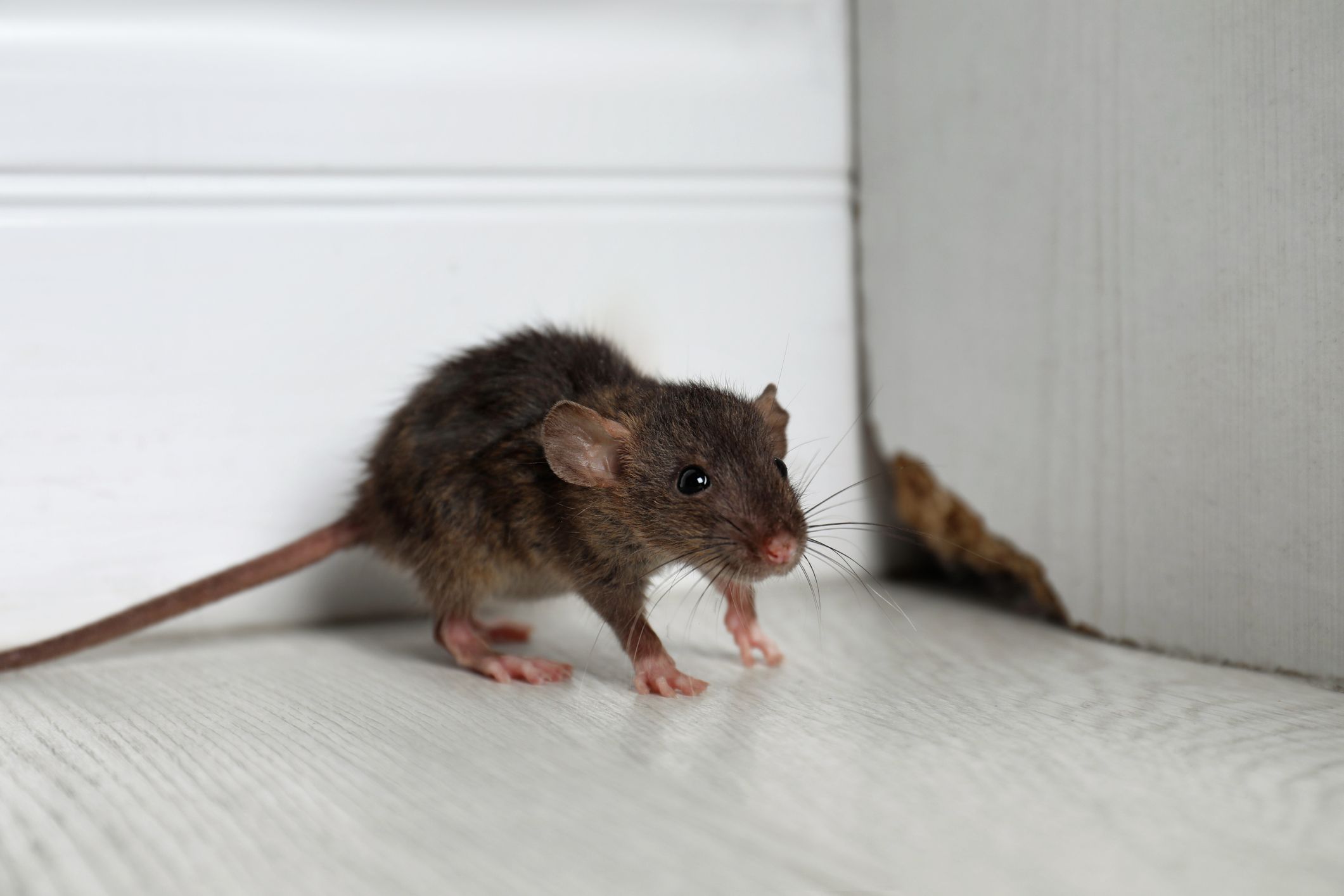
 torontosun.com
torontosun.com
Author of the article:Kevin Connor
Publishing date:Oct 23, 2022 • 11 hours ago • 2 minute read • Join the conversation
GONE TO THE RATS: Toronto's rodent population booming since pandemic
GONE TO THE RATS: Toronto's rodent population booming since pandemic
Perhaps rats, not raccoons, should be Toronto’s official mascot since their numbers have grown during the pandemic.
Multiple pandemic lockdowns led to bolder rodent activity and migration to residential neighbourhoods, according to Orkin Canada.
As pandemic fears have lessened, and Canadian cities are back in business, food sources are abundantly available in urban areas again for rats.
“With more available food, there will be exponential population growth. Food availability favours population growth since there will be less competition for food, which also will result in high reproductive potential, high survival and healthy thriving populations,” said Alice Sinia, Ph.D. entomologist with Orkin Canada.
But no agency in the city can put an estimated number on how many rats are in the city.
One stat suggests a rat for every person.
The City does not have an estimate of how many rats there are in Toronto, but did share the number of waste- and property-standards-related rodent service requests and the number of rodent complaints mostly linked to food premises.
“On average, under the DineSafe program, Toronto Public Health (TPH) also responds to about 400 rodent complaints a year, of which approximately 80 per cent concern mice and the balance concern rats. Over the past five years, TPH has responded to 1,906 rodent complaints mostly linked to food premises,” the city said in an email.
“From time to time rodent populations tend to increase in areas across the city where they are able to find harbourage, food and water. Noise and vibration from construction projects can also upset rodent habitats and displace populations.”
During construction, contractors have to follow the Ontario Occupational Health and Safety Act and need to take action to protect workers and the public against any hazards, which includes biological hazards the presence of rodents would create.
Actions to address rodents could include reporting it to the contract administrator so appropriate arrangements can be made according to the Act.
On private property, residents and business owners are responsible for maintaining their own properties to prevent any rodent infestations, and should use private pest control services.
“If the city needs a mascot, I’d vote for raccoon since they are a native wild animal. Norway rats are an introduced species, but I do love rats and feel they are undeserving of the bad reputation they usually have,” said Nathalie Karvonen with the Toronto Wildlife Centre.

GONE TO THE RATS: Toronto's rodent population booming since pandemic
Rats, not raccoons, should be Toronto’s official mascot as their numbers have grown since the pandemic.
Huh…We used wood cutlery this summer.So now, the same group that made us ban paper bags and straws because they "might" be made from old growth forests have decided that single use plastics are not good and we now use paper straws and wooden "knives and forks" because wood is recyclable.

The new ban, announced on Wednesday, includes single-use bags of all sizes supplied by retailers to customers.
However, there will be some exceptions to the bag ban, such as prescription bags, take-out food bags, bags for bulk items, tire bags, produce bags and bags for live fish, flower or potted plants.
Paper bags for live fish? Really?
The move comes a year after Yukon’s ban on single-use plastic bags, which has been in effect since Jan. 1, 2022.
The Yukon government says this latest ban is meant to help protect the environment and reduce waste as production and transportation of single-use products is resource-intensive and creates emissions.
Yukon is banning single-use paper bags starting next year — CTV News
Starting Jan. 1. 2023, single-use paper bags will be banned in Yukon, the territory’s government has announced.
Huh…We used wood cutlery this summer.
View attachment 16302
However, there will be some exceptions to the bag ban, such as prescription bags, take-out food bags, bags for bulk items, tire bags, produce bags and bags for live fish, flower or potted plants.
Paper bags for live fish? Really?
The move comes a year after Yukon’s ban on single-use plastic bags, which has been in effect since Jan. 1, 2022.
The Yukon government says this latest ban is meant to help protect the environment and reduce waste as production and transportation of single-use products is resource-intensive and creates emissions.

Yukon is banning single-use paper bags starting next year — CTV News
Starting Jan. 1. 2023, single-use paper bags will be banned in Yukon, the territory’s government has announced.apple.news
Old guy who was a musher lives in BC and has made REALLY gorgeous wooden knives and such this past summer.
Has to find some joy after the BCSPCA stole his dogs, killed two and the rest went off to other homes.
That’s just shitty. Sounds PETA-ish.
From what I've heard, BCSPCA has been taken over by PETA types, will do random seizures for big cash returns (just killed a mini horse they took from someone who already had it under vet care, even though their excuse was lack of) and it's just been horrible. A lot of SPCA's are turning into this thanks to ART (animal rights terrorists) types.
In the Yukon it all goes in the burn barrel. Plastic paper whatever. Who are they trying to fool?Huh…We used wood cutlery this summer.
View attachment 16302
However, there will be some exceptions to the bag ban, such as prescription bags, take-out food bags, bags for bulk items, tire bags, produce bags and bags for live fish, flower or potted plants.
Paper bags for live fish? Really?
The move comes a year after Yukon’s ban on single-use plastic bags, which has been in effect since Jan. 1, 2022.
The Yukon government says this latest ban is meant to help protect the environment and reduce waste as production and transportation of single-use products is resource-intensive and creates emissions.

Yukon is banning single-use paper bags starting next year — CTV News
Starting Jan. 1. 2023, single-use paper bags will be banned in Yukon, the territory’s government has announced.apple.news
Ancient bison bones unearthed at Saanich, BC construction site
The bones likely come from one large animal at the time of glacial retreat, a paleontologist says
Author of the article:Jeff Bell • Victoria Times Colonist
Publishing date:Nov 05, 2022 • 2 days ago • 2 minute read • 10 Comments
Ed Davies with old bison bones found at the excavation site for a new Nigel House near Saanich Municipal Hall.
Ed Davies with old bison bones found at the excavation site for a new Nigel House near Saanich Municipal Hall. PHOTO BY ADRIAN LAM /TIMES COLONIST
Article content
VICTORIA — Bison bones that are as much as 14,000 years old have been unearthed at the construction site for the new Nigel House, a home for adults with disabilities near Saanich Municipal Hall.
What it feels like: A positive outlook on a disease without a treatment
Trackerdslogo
The first bones turned up during excavation work in October, with more discovered Friday by workers, said paleontologist and geologist Ed Davies, who was brought in to help deal with the ancient relics.
“We found two shoulder blades, a couple of ribs, a whole bunch of toe bones, several vertebra and one horn,” Davies said. “We’ve got quite a good representation of what appears to be one animal.”
Davies said it’s rare to find multiple elements of one animal in context “to work out the environment that it was living in.”
The bones, which have been taken to the Royal B.C. Museum for carbon-14 dating and DNA tests, were found in “marine sediment,” indicating there was flooding in the area at the time, as a glacier covering the land was melting, he said.
That shows there were bison around at the time of the glacial retreat, Davies said: “That’s kind of important and it means that there might have been a large-animal food source for people who were migrating into the area.”
The area also included a sandbar populated with clams and snails.
Close up of bison scapula and rib bones. Via Ed Davies
Close up of bison scapula and rib bones. Via Ed Davies
The discovery of bones this old and this intact is “significant,” said Davies, who suspects they come from a very large male bison up to five metres long.
The bones found Friday, including a foreleg, came from the pile of material left from the original excavation, and are likely from the same bison remains located earlier, he said.
He said bison bones were also found a number of years ago during construction work at Cook and Haultain streets.
Work was immediately halted in the area of the first find Oct. 19 so the bones could be protected. The recovery plan was approved by the B.C. Fossil Management Office, and the Esquimalt and Songhees First Nations were contacted.
Derrick Bernardo, chief executive of Broadmead Care — which owns and operates Nigel House — said residents of the existing Nigel House adjacent to the site have been closely watching the work and are excited about the find.
Bernardo said there will probably be some sort of acknowledgment of the bones at the new facility, perhaps using pictures or castings. “We could display that and showcase our find.”
Read more from the Times Colonist.

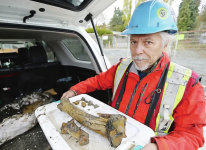

 torontosun.com
torontosun.com
The bones likely come from one large animal at the time of glacial retreat, a paleontologist says
Author of the article:Jeff Bell • Victoria Times Colonist
Publishing date:Nov 05, 2022 • 2 days ago • 2 minute read • 10 Comments
Ed Davies with old bison bones found at the excavation site for a new Nigel House near Saanich Municipal Hall.
Ed Davies with old bison bones found at the excavation site for a new Nigel House near Saanich Municipal Hall. PHOTO BY ADRIAN LAM /TIMES COLONIST
Article content
VICTORIA — Bison bones that are as much as 14,000 years old have been unearthed at the construction site for the new Nigel House, a home for adults with disabilities near Saanich Municipal Hall.
What it feels like: A positive outlook on a disease without a treatment
Trackerdslogo
The first bones turned up during excavation work in October, with more discovered Friday by workers, said paleontologist and geologist Ed Davies, who was brought in to help deal with the ancient relics.
“We found two shoulder blades, a couple of ribs, a whole bunch of toe bones, several vertebra and one horn,” Davies said. “We’ve got quite a good representation of what appears to be one animal.”
Davies said it’s rare to find multiple elements of one animal in context “to work out the environment that it was living in.”
The bones, which have been taken to the Royal B.C. Museum for carbon-14 dating and DNA tests, were found in “marine sediment,” indicating there was flooding in the area at the time, as a glacier covering the land was melting, he said.
That shows there were bison around at the time of the glacial retreat, Davies said: “That’s kind of important and it means that there might have been a large-animal food source for people who were migrating into the area.”
The area also included a sandbar populated with clams and snails.
Close up of bison scapula and rib bones. Via Ed Davies
Close up of bison scapula and rib bones. Via Ed Davies
The discovery of bones this old and this intact is “significant,” said Davies, who suspects they come from a very large male bison up to five metres long.
The bones found Friday, including a foreleg, came from the pile of material left from the original excavation, and are likely from the same bison remains located earlier, he said.
He said bison bones were also found a number of years ago during construction work at Cook and Haultain streets.
Work was immediately halted in the area of the first find Oct. 19 so the bones could be protected. The recovery plan was approved by the B.C. Fossil Management Office, and the Esquimalt and Songhees First Nations were contacted.
Derrick Bernardo, chief executive of Broadmead Care — which owns and operates Nigel House — said residents of the existing Nigel House adjacent to the site have been closely watching the work and are excited about the find.
Bernardo said there will probably be some sort of acknowledgment of the bones at the new facility, perhaps using pictures or castings. “We could display that and showcase our find.”
Read more from the Times Colonist.



Ancient bison bones unearthed at Saanich construction site
Bison bones as many as 14,000 years old have been unearthed near Saanich Municipal Hall.
French woman grows nose on arm to prepare for transplant
The unnamed patient from Toulouse, France, had lost a large portion of her nose while being treated for cancer of the nasal cavity in 2013.
Author of the article ostmedia News
ostmedia News
Publishing date:Nov 10, 2022 • 3 days ago • 1 minute read • Join the conversation
The unnamed patient from Toulouse, France, had lost a large portion of her nose while being treated for cancer of the nasal cavity in 2013.
The unnamed patient from Toulouse, France, had lost a large portion of her nose while being treated for cancer of the nasal cavity in 2013. PHOTO BY SCREENGRAB /CHU de Toulouse
A French woman grew a nose on her arm to prepare for a transplant.
The unnamed patient from Toulouse, France, had lost a large portion of her nose while being treated for cancer of the nasal cavity in 2013.
Reconstruction attempts and prosthetics failures left her in that situation until advanced medical technologies provided a new solution, her growing a new nose herself.
A custom nose, made from 3D-printed biomaterial to replace cartilage, was made for her and then implanted on her forearm, according to the Evening Standard.
It was done by using a skin graft from her temple to cover the replacement nose. Then the nose grew on her arm for a couple of months before being transplanted to her face, according to the report.
Later, microsurgery was used to connect blood vessels in the arm to vessels in the face.
“After 10 days of hospitalization and three weeks of antibiotics, the patient is doing very well,” medics told the Evening Standard.
“This type of reconstruction had never before been performed on such a fragile and poorly vascularised area and was made possible thanks to the collaboration of the medical teams with the company Cerhum, a Belgian manufacturer of medical devices specializing in bone reconstruction,” the hospital said. “This new technique also makes it possible to overcome certain limitations presented by other techniques.”
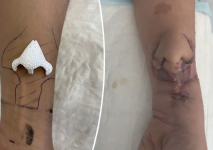

 standard.co.uk
standard.co.uk
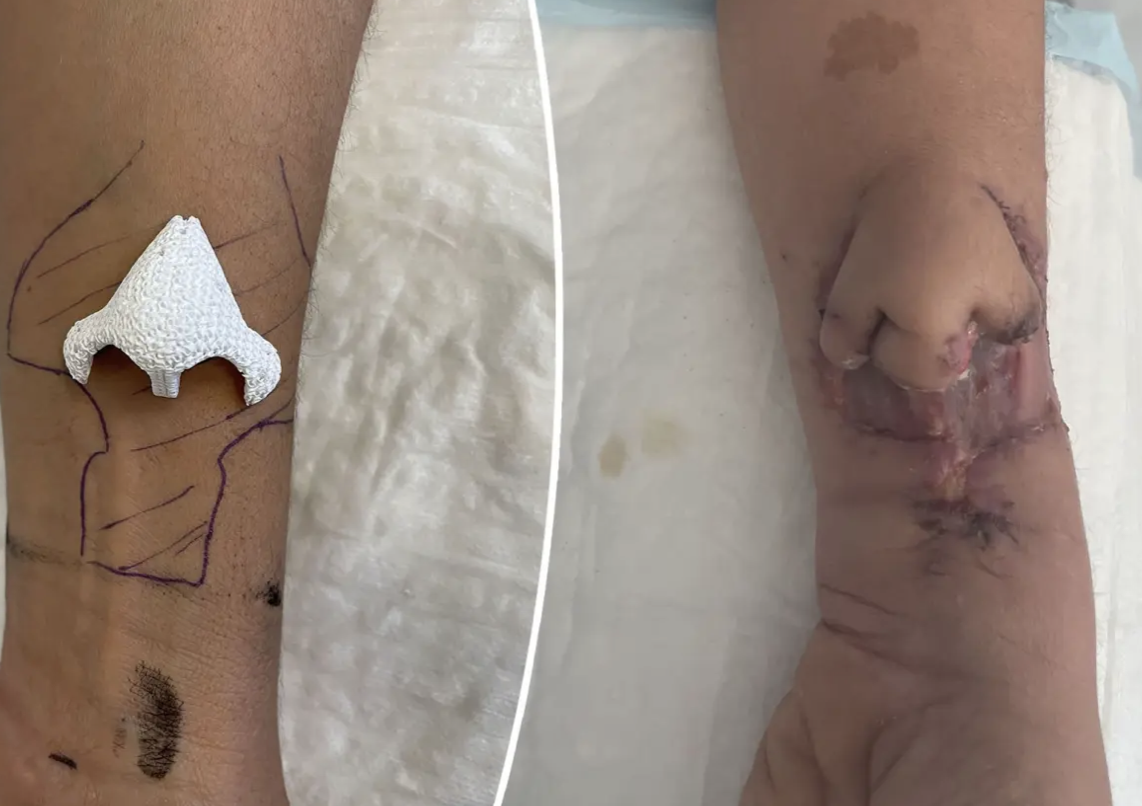
 torontosun.com
torontosun.com
The unnamed patient from Toulouse, France, had lost a large portion of her nose while being treated for cancer of the nasal cavity in 2013.
Author of the article
Publishing date:Nov 10, 2022 • 3 days ago • 1 minute read • Join the conversation
The unnamed patient from Toulouse, France, had lost a large portion of her nose while being treated for cancer of the nasal cavity in 2013.
The unnamed patient from Toulouse, France, had lost a large portion of her nose while being treated for cancer of the nasal cavity in 2013. PHOTO BY SCREENGRAB /CHU de Toulouse
A French woman grew a nose on her arm to prepare for a transplant.
The unnamed patient from Toulouse, France, had lost a large portion of her nose while being treated for cancer of the nasal cavity in 2013.
Reconstruction attempts and prosthetics failures left her in that situation until advanced medical technologies provided a new solution, her growing a new nose herself.
A custom nose, made from 3D-printed biomaterial to replace cartilage, was made for her and then implanted on her forearm, according to the Evening Standard.
It was done by using a skin graft from her temple to cover the replacement nose. Then the nose grew on her arm for a couple of months before being transplanted to her face, according to the report.
Later, microsurgery was used to connect blood vessels in the arm to vessels in the face.
“After 10 days of hospitalization and three weeks of antibiotics, the patient is doing very well,” medics told the Evening Standard.
“This type of reconstruction had never before been performed on such a fragile and poorly vascularised area and was made possible thanks to the collaboration of the medical teams with the company Cerhum, a Belgian manufacturer of medical devices specializing in bone reconstruction,” the hospital said. “This new technique also makes it possible to overcome certain limitations presented by other techniques.”


Groundbreaking surgery sees nose grown on woman’s arm then grafted onto her face
She was left without a nose after being treated for nasal cancer in 2013

French woman grows nose on arm to prepare for transplant
A French woman grew a nose on her arm to prepare for a transplant.
Falling sperm count a global phenomenon: Study
Author of the article:Liz Braun
Publishing date:Nov 15, 2022 • 1 day ago • 2 minute read
An Israeli-led study has found sperm counts have plummeted by 62% in under 50 years, and the findings have implications for the future of the human race.
An Israeli-led study has found sperm counts have plummeted by 62% in under 50 years, and the findings have implications for the future of the human race.
Sperm counts are declining globally.
An Israeli-led study has found sperm counts have plummeted by 62% in under 50 years, and the findings have implications for the future of the human race.
Prof. Hagai Levine of the Hebrew University of Jerusalem led the study with Prof. Shanna Swan at New York’s Icahn School of Medicine.
The Times of Israel reports that the results are particularly worrying as a low sperm count is considered an indication of male health in general and may point to increased risk for testicular cancer and chronic disease.
Professor Levine’s last study was done in 2017. The new study adds several years of statistics and is much broader, covering 53 countries.
Sperm concentration per millilitre of semen is currently at about 50 million — which is down by by 52%. The figure considered to indicate a low sperm concentration is 15 million per millilitre, so levels are still above that number.
But Professor Levine noted that an average of 50 million means there are many men who have under 40 million, “fertility that is actually suboptimal.”
The study was published in the Human Reproduction Update.
As rates of decline are actually accelerating, according to The Guardian, a reproductive crisis is possible.
Professor Richard Sharpe, an expert in male reproductive health at the University of Edinburgh, noted this is a worldwide issue and said the key takeaway in the research is that this could be, “desperately bad news for couple fertility.”
Environmental factors are suspected to be the culprit here. Lifestyle factors that contribute to poor health, such as poor diet, obesity, smoking and drinking, may also play a role.
Among the chemicals believed to affect sperm quality are bisphenols and dioxins, which are thought to interfere with hormones. Paracetamol and phthalates also pose a risk.
Other male disorders, such as penis malformation and undescended testes are also on the increase, and hormone-disrupting chemicals are suspected. The damage happens in utero, as the baby develops.
Paracetamol is also known as acetaminophen — Tylenol. Scientists have warned pregnant women against using acetaminophen in the past and paracetamol has been shown to cause a decline in sperm quality in laboratory animals.
Processed food and fatty foods can be sources of dioxins, phthalates and bisphenols.

 pubmed.ncbi.nlm.nih.gov
pubmed.ncbi.nlm.nih.gov

 theguardian.com
theguardian.com

 theguardian.com
theguardian.com

 academic.oup.com
academic.oup.com

 timesofisrael.com
timesofisrael.com

Author of the article:Liz Braun
Publishing date:Nov 15, 2022 • 1 day ago • 2 minute read
An Israeli-led study has found sperm counts have plummeted by 62% in under 50 years, and the findings have implications for the future of the human race.
An Israeli-led study has found sperm counts have plummeted by 62% in under 50 years, and the findings have implications for the future of the human race.
Sperm counts are declining globally.
An Israeli-led study has found sperm counts have plummeted by 62% in under 50 years, and the findings have implications for the future of the human race.
Prof. Hagai Levine of the Hebrew University of Jerusalem led the study with Prof. Shanna Swan at New York’s Icahn School of Medicine.
The Times of Israel reports that the results are particularly worrying as a low sperm count is considered an indication of male health in general and may point to increased risk for testicular cancer and chronic disease.
Professor Levine’s last study was done in 2017. The new study adds several years of statistics and is much broader, covering 53 countries.
Sperm concentration per millilitre of semen is currently at about 50 million — which is down by by 52%. The figure considered to indicate a low sperm concentration is 15 million per millilitre, so levels are still above that number.
But Professor Levine noted that an average of 50 million means there are many men who have under 40 million, “fertility that is actually suboptimal.”
The study was published in the Human Reproduction Update.
As rates of decline are actually accelerating, according to The Guardian, a reproductive crisis is possible.
Professor Richard Sharpe, an expert in male reproductive health at the University of Edinburgh, noted this is a worldwide issue and said the key takeaway in the research is that this could be, “desperately bad news for couple fertility.”
Environmental factors are suspected to be the culprit here. Lifestyle factors that contribute to poor health, such as poor diet, obesity, smoking and drinking, may also play a role.
Among the chemicals believed to affect sperm quality are bisphenols and dioxins, which are thought to interfere with hormones. Paracetamol and phthalates also pose a risk.
Other male disorders, such as penis malformation and undescended testes are also on the increase, and hormone-disrupting chemicals are suspected. The damage happens in utero, as the baby develops.
Paracetamol is also known as acetaminophen — Tylenol. Scientists have warned pregnant women against using acetaminophen in the past and paracetamol has been shown to cause a decline in sperm quality in laboratory animals.
Processed food and fatty foods can be sources of dioxins, phthalates and bisphenols.

Effect of paracetamol on semen quality - PubMed
Several published studies, both direct and indirect, have connected paracetamol, also named acetaminophen, a commonly used over-the-counter analgesic and antipyretic medication, with semen quality and male infertility, although as yet this connection is unclear. This review addresses the effect...

Cocktail of chemical pollutants linked to falling sperm quality in research
Exclusive: Study finds mixtures of compounds thought to disrupt hormones are present in people at ‘astonishing’ levels

Humans could face reproductive crisis as sperm count declines, study finds
Global figures suggest sperm concentration has halved in 40 years – and the rate of decline is accelerating

Temporal trends in sperm count: a systematic review and meta-regression analysis
AbstractBACKGROUND. Reported declines in sperm counts remain controversial today and recent trends are unknown. A definitive meta-analysis is critical give

Sperm counts worldwide have plunged 62% in under 50 years, Israeli-led study finds
Finding is bad news for fertility and men’s health, says co-author Prof. Hagai Levine, adding that if the decline continues, it ‘could threaten humankind’s survival.’

Russia's Shivulech volcano extremely active, threatens eruption: Scientists
Author of the article:Reuters
Reuters
Publishing date:Nov 20, 2022 • 23 hours ago • 1 minute read
This image obtained from NASA, shows an ash plume from the Shiveluch volcano, in Kamchatka Peninsula, in eastern Russia.
This image obtained from NASA, shows an ash plume from the Shiveluch volcano, in Kamchatka Peninsula, in eastern Russia. PHOTO BY HANDOUT/NASA /AFP/Getty Images
The Shiveluch volcano on the Kamchatka Peninsula in the Russian Far East has become extremely active, threatening a powerful eruption, the Kamchatka Volcanic Eruption Response Team said on Sunday.
“A growth of the lava dome continues, a strong fumaroles activity, an incandescence of the lava dome, explosions, and hot avalanches accompanies this process,” the observatory said on its website.
“Ash explosions up to 10-15 kilometres … could occur at any time. Ongoing activity could affect international and low-flying aircraft.”
Russia’s state RIA news agency cited Alexei Ozerov, the director of the Institute of Volcanology and Seismology of the Far East Branch of the Russian Academy of Sciences, as saying that the dome of the volcano is very hot.
![Shiveluch-scaled-e1668978896305[1].jpg Shiveluch-scaled-e1668978896305[1].jpg](https://forums.canadiancontent.net/data/attachments/14/14776-d9b29c6ffe93ca39f7565a5efd42595f.jpg)
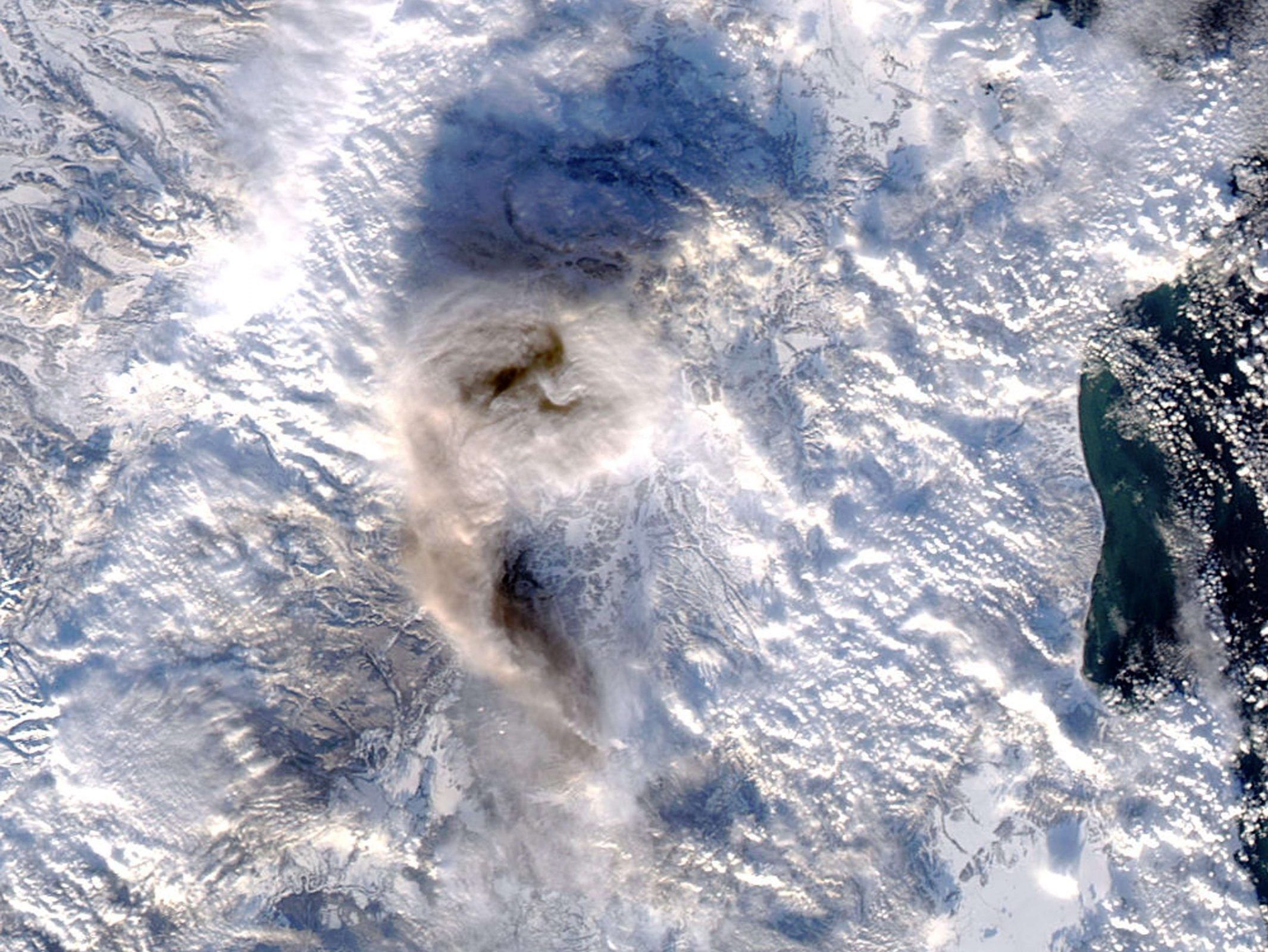
 torontosun.com
torontosun.com
Author of the article:Reuters
Reuters
Publishing date:Nov 20, 2022 • 23 hours ago • 1 minute read
This image obtained from NASA, shows an ash plume from the Shiveluch volcano, in Kamchatka Peninsula, in eastern Russia.
This image obtained from NASA, shows an ash plume from the Shiveluch volcano, in Kamchatka Peninsula, in eastern Russia. PHOTO BY HANDOUT/NASA /AFP/Getty Images
The Shiveluch volcano on the Kamchatka Peninsula in the Russian Far East has become extremely active, threatening a powerful eruption, the Kamchatka Volcanic Eruption Response Team said on Sunday.
“A growth of the lava dome continues, a strong fumaroles activity, an incandescence of the lava dome, explosions, and hot avalanches accompanies this process,” the observatory said on its website.
“Ash explosions up to 10-15 kilometres … could occur at any time. Ongoing activity could affect international and low-flying aircraft.”
Russia’s state RIA news agency cited Alexei Ozerov, the director of the Institute of Volcanology and Seismology of the Far East Branch of the Russian Academy of Sciences, as saying that the dome of the volcano is very hot.
![Shiveluch-scaled-e1668978896305[1].jpg Shiveluch-scaled-e1668978896305[1].jpg](https://forums.canadiancontent.net/data/attachments/14/14776-d9b29c6ffe93ca39f7565a5efd42595f.jpg)

Russia's Shivulech volcano extremely active, threatens eruption: Scientists
The Shiveluch volcano on the Kamchatka Peninsula in Russia has become extremely active, threatening a powerful eruption, scientists say.